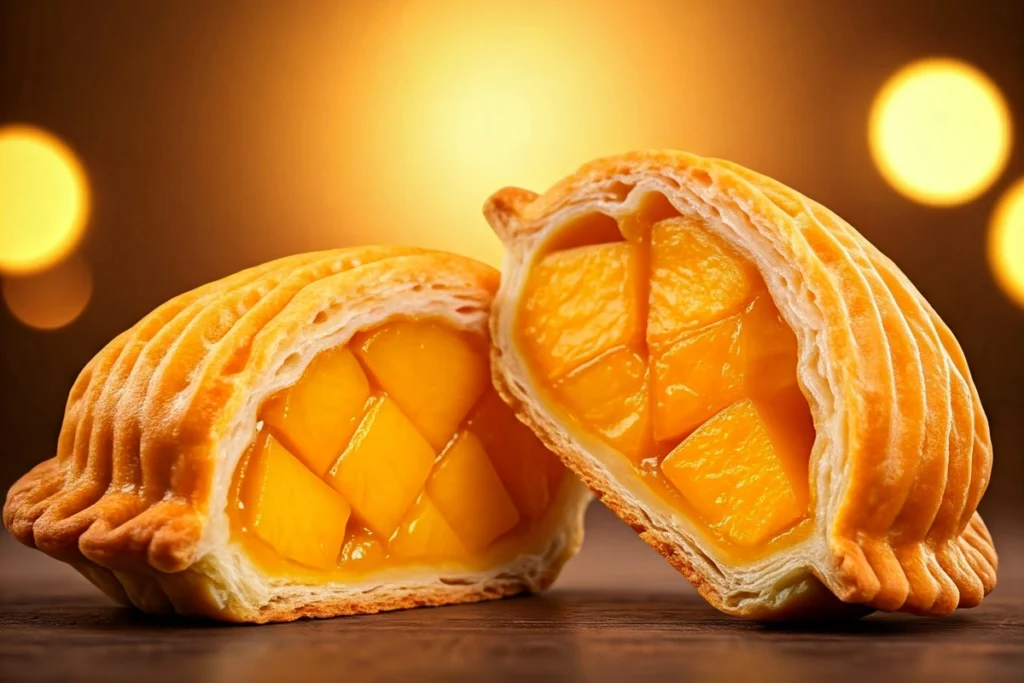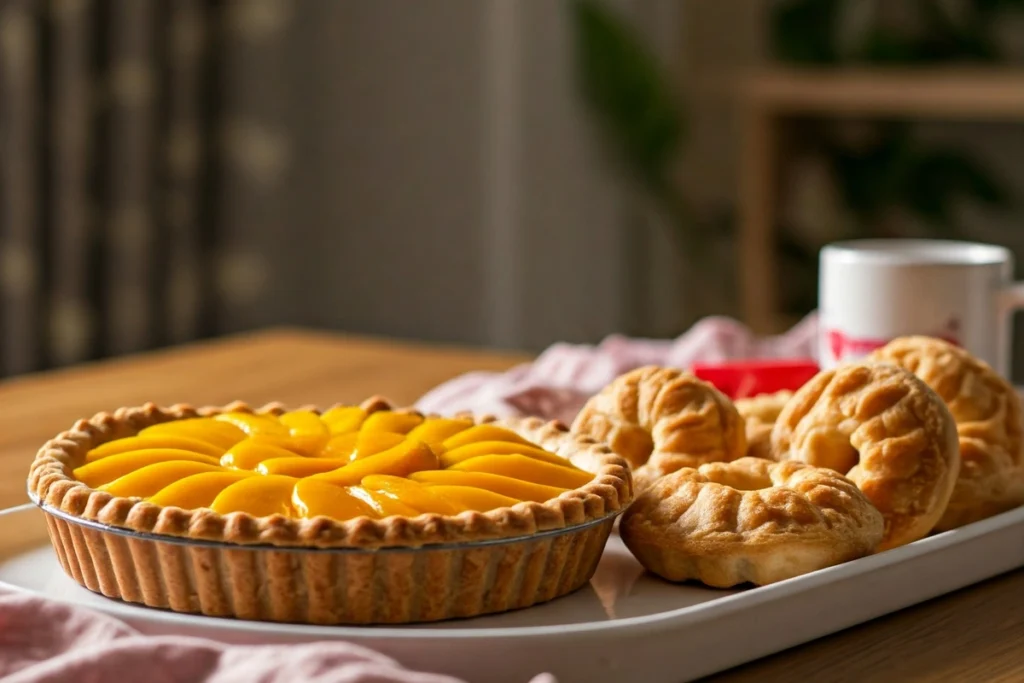Experience the fruity delight of peach mango pie jollibee. Learn its origins, baking tips, and mouthwatering variations for a sweet tropical treat.
What Makes Peach Mango Pie Jollibee So Irresistible
Filipino fast-food culture boasts many unique dishes. However, one standout favorite is the peach mango pie jollibee creation. This crispy, golden turnover has gained international acclaim for its bright fruit filling. Indeed, it combines sweet peaches and tangy mangoes inside a crunchy pastry shell. The result is a balance of flavors and textures that captivates dessert lovers across the globe.
Originally, Jollibee set out to develop a dessert that reflected the Philippines’ tropical fruit heritage. Mango is the national fruit, while peaches add a subtle sweetness. Consequently, the peach mango pie jollibee dessert was born. Initially, only a few locations sold it, but people quickly fell in love with this fruity pastry. Eventually, it became a permanent menu item that travelers and locals crave alike.
Many fans adore how the delicate crust breaks open to reveal a luscious, gooey center. Meanwhile, the aroma of caramelized fruit piques your taste buds before you even take a bite. Undoubtedly, it’s a decadent treat that consistently delights diners who yearn for a taste of the tropics. Comparatively, other fast-food chains may offer fruit pies, but none match the distinctive blend of peach and mango found here.
Although it is often enjoyed on the go, the peach mango pie jollibee can also become an indulgent treat at home. Serve it with ice cream, whipped cream, or even a dusting of powdered sugar. Altogether, each approach highlights the bright filling and crisp exterior. Therefore, it remains versatile enough for both casual snacking and celebratory occasions.
Because this turnover is so popular, many home cooks have tried replicating it in their own kitchens. They test different dough recipes, fruit ratios, and cooking methods. Consequently, several do-it-yourself guides have surfaced, showcasing creative ways to mirror the taste and texture. In this article, you’ll learn how to craft a homemade version and discover the best serving options.
How to Recreate the Peach Mango Pie Jollibee Experience
Reproducing the beloved flavor of peach mango pie jollibee at home is easier than you might think. Chiefly, you need sweet, ripe mangoes and high-quality peaches. Additionally, you need a sturdy yet flaky crust. Because this dessert is typically fried or baked to golden perfection, it’s essential to choose a dough that can withstand high temperatures without becoming greasy or soggy.
Selecting Your Ingredients
Choosing the right ingredients sets the stage for success. First, opt for fresh or canned peaches if you prefer a consistent level of sweetness. Ripe peaches impart a richer flavor, yet canned peaches work nicely in a pinch. Meanwhile, for the mango portion, you can use fresh or frozen fruit. In particular, fresh mangoes produce a brighter taste. However, frozen mango chunks are a convenient alternative when fresh fruit is out of season.
- Peaches: White or yellow peaches both work. Yellow peaches impart a tangier taste. Conversely, white peaches are milder.
- Mangoes: Varieties like Alphonso or Ataulfo deliver intense sweetness. Nonetheless, any ripe, aromatic mango will do.
- Sweeteners: You may opt for white sugar, brown sugar, or honey. Adjust according to personal preference.
- Dough: A pie crust dough or puff pastry is commonly used. Both yield satisfying crispness when fried or baked.
Basically, your aim is to meld peaches and mangoes into a jam-like filling that doesn’t leak. Hence, cornstarch is a typical thickener. Furthermore, a dash of lemon juice can brighten the flavors. Indeed, it brings out the tangy notes in the fruit medley.
Preparing the Filling
Begin by peeling and chopping the peaches into small cubes. Do the same for your mangoes if you’re using fresh fruit. Place the fruit in a saucepan over medium heat, then add sugar to taste. Because peaches and mangoes differ in sweetness, sample the mixture to avoid over-sweetening. Add cornstarch and stir, ensuring no lumps remain. Eventually, the filling will thicken and become glossy.
You can also include a touch of salt to contrast the sugary component. This helps intensify the natural fruit flavors. Likewise, some cooks add spices like cinnamon or nutmeg. Still, the classic peach mango pie jollibee relies mainly on the purity of peach and mango. Consequently, subtlety often works best.
After the filling thickens, remove it from heat and let it cool. This step is vital. If it’s too hot, the dough could become soggy. Equally, waiting allows the flavors to meld. Once cooled, your filling is ready for assembly.
Crafting the Dough
For an authentic version, you want a crust that remains crunchy on the outside and soft within. Thus, a well-chilled pastry dough is essential. If you’re short on time, store-bought puff pastry can suffice. However, for a more homemade feel, prepare a simple dough by blending flour, butter, salt, and ice-cold water. Eventually, shape the dough into a disk, wrap it, and chill for at least an hour.
When you’re ready, roll out the dough on a floured surface until it’s about an eighth of an inch thick. Then, cut it into rectangles or circles, based on your preferred shape. Take a spoonful of cooled filling and place it in the center of each piece. Be careful not to overfill, or the turnover might burst during cooking.
Cooking Methods
Traditionally, peach mango pie jollibee is deep-fried. This yields a golden exterior that crackles with each bite. Alternatively, you can bake your turnovers at 375°F until crisp and brown. Another option is air-frying them for a lower-fat version. Simply brush the pastries with oil, then air-fry at around 350°F for 10 to 15 minutes, flipping once. In any case, aim for a consistent, light brown color.
If you fry them, monitor the oil temperature. If it’s too hot, the dough might burn before the filling warms fully. Consequently, a thermometer proves helpful. Conversely, if the oil is too cool, the pastry absorbs excess oil and becomes greasy. Strive for about 350°F to 360°F for optimal results.
Tips for Serving the Perfect Peach Mango Pie Jollibee
Serving your homemade turnovers can be as simple or elaborate as you wish. Generally, they taste best when served warm. The gooey filling contrasts nicely with the crunchy dough, making each bite memorable. Additionally, you can dress them up with garnishes:
- Powdered Sugar: Lightly dust each pastry for a sweet finish.
- Ice Cream: A scoop of vanilla, coconut, or mango ice cream complements the tropical flavors.
- Whipped Cream: Top each pie with fresh whipped cream and a sprig of mint.
- Fruit Coulis: Drizzle a mango or peach puree for added color.
Undoubtedly, these embellishments enhance the overall experience. However, sometimes the best approach is simply enjoying them fresh from the oven (or fryer). Meanwhile, consider pairing them with a warm beverage like tea or coffee. Particularly, black tea or espresso intensifies the fruity sweetness.
Storing Leftovers
If you make a large batch, store extras properly so they remain appetizing. Once the pies have cooled, place them in an airtight container. Keep them at room temperature for up to two days. However, for longer storage, refrigerate them. They will keep fresh for about four days. You can also freeze your turnovers for up to a month. Reheat them in an oven or air fryer to preserve the crisp exterior.
Exploring Peach Mango Pie Jollibee Variations
Although the classic peach mango pie jollibee is undeniably tasty, experimentation can yield delightful new flavors. For instance, add a sprinkle of shredded coconut to the filling. Alternatively, incorporate a few pineapple chunks for extra zing. Moreover, you might drizzle caramel sauce inside for a sweeter variation. Eventually, you’ll discover a custom twist that suits your palate.
Some bakers even transform the filling into jam or chutney for other recipes. Another approach is combining peaches and mangoes with cream cheese for a richer filling. However, the original recipe remains iconic. Because the simple mix of sweet peaches and tangy mango is already a winning combination, many prefer to keep it traditional.
The Popularity of Peach Mango Pie Jollibee Worldwide
Over the years, Jollibee has expanded to multiple countries. Thus, the peach mango pie jollibee phenomenon spread to the United States, Canada, and beyond. People line up for this beloved dessert, sometimes traveling miles to indulge. This popularity isn’t surprising, given how unique it is among typical fast-food offerings. Additionally, social media influencers have raved about it, further boosting its reputation.
Jollibee’s dessert quickly became a symbol of Filipino culinary pride abroad. Basically, it demonstrates how local flavors can captivate a global audience. It also serves as a nostalgic treat for Filipinos overseas who miss home. Consequently, the brand’s success with this iconic product paved the way for other tropical-inspired dishes to gain international attention.
Foodies love documenting their experiences online. Many post pictures of the crispy pies, revealing the vivid peach-and-mango filling. Others share homemade attempts on blogs and social media platforms. Altogether, these efforts showcase the dessert’s versatility and encourage more people to try it.
Why the Peach Mango Pie Jollibee Stands Out
Filipino cuisine is known for blending sweet, savory, and tangy elements. Indeed, the peach mango pie jollibee captures that spirit in a compact form. Firstly, the contrast of textures—soft fruit against crunchy pastry—keeps each bite exciting. Secondly, the combination of peach and mango is refreshingly tropical, appealing to those who enjoy exotic flavors. Thirdly, the pie’s portability makes it convenient for snacking on busy days.
In addition, nostalgia plays a huge role. Many Filipinos grew up enjoying this pastry, associating it with childhood memories and family gatherings. Furthermore, the strong branding by Jollibee only heightened its cultural significance. Because of this, every new bite reminds fans of home-cooked meals and celebrations.
Comparatively, the Western apple pie might be more familiar to U.S. audiences. However, the peach mango pie jollibee offers a bright alternative that resonates with the desire for something new. In many ways, this dessert is an edible ambassador for Filipino flavors. Additionally, it can lead curious eaters to explore more traditional Filipino dishes like halo-halo or lechon.

How to Add a Cultural Twist
Those who want to make their pies extra special can incorporate other Filipino ingredients. Ube, or purple yam, is a well-loved flavor. Indeed, swirling a bit of ube puree into the fruit filling yields a colorful surprise. Alternatively, a bit of calamansi juice can replace lemon juice for a distinct citrus note. These slight modifications maintain the essence of peach mango pie jollibee while giving it a personal spin.
Common Mistakes When Making Peach Mango Pie Jollibee
- Overfilling: Too much fruit can lead to messy leaks. Consequently, sealing the edges becomes difficult.
- Not Chilling the Dough: Warm dough doesn’t puff or crisp well. Additionally, it may stick to surfaces.
- High Heat Frying: If the oil is too hot, the exterior browns too quickly, leaving raw pastry inside.
- Insufficient Thickener: Without enough cornstarch, the filling becomes runny and may soak through the crust.
Remember these pitfalls before you begin. Making a perfect batch requires attention to detail. However, practice and patience ensure you’ll get the hang of it.
Pairing Suggestions
Wondering how to make your turnover even more special? Here are some ideas:
- Vanilla Milkshake: The creamy sweetness heightens the tropical fruit flavors.
- Tropical Smoothie: Mango, pineapple, or coconut-based drinks create a full island experience.
- Herbal Tea: A mild tea lets the pie’s flavors shine. Chamomile or mint tea can be particularly soothing.
- Light Cocktail: A refreshing mojito or daiquiri pairs well with the fruity essence.
Meanwhile, if you want a more traditional pairing, black coffee complements the pie’s sugary profile. Comparatively, adding sweetened condensed milk to your coffee can echo the richness of the fruit filling.
Storing and Reheating Tips
Crispness diminishes over time, so it’s best to enjoy your peach mango pie jollibee turnover right away. However, if you have leftovers, store them in a paper-lined container to absorb moisture. When you’re ready for a second helping, reheat in a preheated oven at 350°F for about 10 minutes. Alternatively, an air fryer also works well. In contrast, microwaving can make the crust soggy, so avoid it if you want to maintain crispness.
If you plan to freeze them, do so before frying or baking. Place assembled turnovers on a tray, then freeze until solid. Afterward, transfer them to freezer bags. Consequently, they’ll keep for up to a month. You can fry or bake them directly from frozen. Just extend the cooking time slightly.
Historical Roots and Global Impact
Jollibee started as a humble ice cream parlor in the Philippines. Eventually, it evolved into the country’s largest fast-food chain. The brand’s distinctive offerings, such as Chickenjoy and peach mango pie jollibee, have endeared it to millions. Over time, Filipinos abroad longed for a taste of home. As a result, Jollibee opened international branches to meet that demand. These expansions popularized Filipino cuisine globally.
Because the peach mango pie jollibee exemplifies a fusion of local produce and Western pastry techniques, it stands as a testament to cultural blending. Filipino food traditions emphasize fresh fruit. Consequently, the brand found a way to feature these fruits in a portable dessert. Meanwhile, the consistent quality and taste across numerous countries ensured that travelers recognized the treat immediately. Indeed, it has become an edible symbol of Filipino pride and hospitality.
Serving Peach Mango Pie Jollibee for Special Occasions
Though it’s a fast-food staple, you can easily incorporate this dessert into fancy gatherings. Place each turnover on a plate drizzled with raspberry coulis or garnished with edible flowers. The bright color of the fruit filling stands out beautifully on white serving ware. Alternatively, cut each pastry in half and serve it with fresh fruit slices to create a vibrant dessert platter.
Many families in the Philippines serve these pies during holidays. They also give them as gifts, knowing how beloved they are. If you’re hosting a multicultural event, consider offering these pastries alongside more traditional American desserts like brownies or cupcakes. The contrast intrigues guests and sparks conversation about global culinary traditions.
Exploring Regional Twists
Some Filipino regions incorporate local produce into dessert variations. For instance, certain households might add banana slices or even jackfruit. However, the core identity of peach mango pie jollibee stays consistent: a crispy crust enveloping sweet fruit. Meanwhile, adventurous bakers might swap out peaches for other stone fruits like nectarines or apricots. The outcome remains similarly delicious, showcasing how adaptable this recipe can be.
Final Thoughts on This Iconic Pastry
The peach mango pie jollibee is more than just a sweet treat. Essentially, it embodies the tropical vibrancy of Filipino cuisine. Its irresistible flavors, crunchy shell, and luscious fruit center have earned it fans across cultural and geographical boundaries. Indeed, one bite is often enough to convert newcomers into loyal devotees. Because of this popularity, many home cooks replicate the recipe themselves, spreading the love even further.
If you’ve never tried it, consider making it from scratch for an authentic taste of the Philippines. Moreover, if you’ve already sampled the official version, challenge yourself to create a personal adaptation. Whether you fry, bake, or air-fry it, this dessert promises to bring a bit of tropical sunshine to your kitchen. Undoubtedly, the peach mango pie jollibee stands as a testament to how simple ingredients can deliver extraordinary flavors.

Frequently Asked Questions About Peach Mango Pie Jollibee
Below is a curated FAQ section inspired by common queries, especially from those curious about Filipino cuisine and pastry-making. (Approximately 200 words)
1) Can I use canned peaches and mangoes for my pie?
Absolutely. Canned fruit works in a pinch. However, drain excess liquid and adjust sugar as needed. Fresh fruit often provides a brighter taste, but canned peaches and mangoes can produce comparable results when fresh produce isn’t available.
2) What’s the best way to get that crispy crust?
Chilling your dough is crucial. Additionally, frying at the correct temperature ensures a crisp texture. If you prefer a lighter option, baking or air-frying yields a crunchy exterior as well, though the texture may differ slightly.
3) Why is the peach mango pie jollibee so popular?
Its unique tropical flavor and crunchy pastry have captivated diners worldwide. Moreover, it offers a nostalgic taste of Filipino cuisine for many, while giving newcomers a sweet introduction to the country’s flavors.
4) Is it possible to make a vegan version?
Yes. Use dairy-free butter or shortening in the dough. Also, choose a plant-based milk wash instead of egg wash. Double-check that your sugar and other ingredients comply with vegan standards.
5) How long can I store homemade turnovers?
They typically last two days at room temperature. Refrigerate or freeze them for extended storage. Reheat them in an oven or air fryer to maintain crispness.
Enjoy experimenting with your own renditions of this iconic treat. Ultimately, peach mango pie jollibee brings a taste of tropical indulgence to any table.

